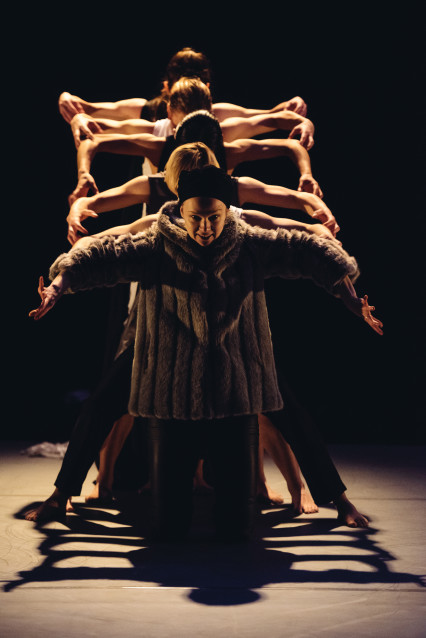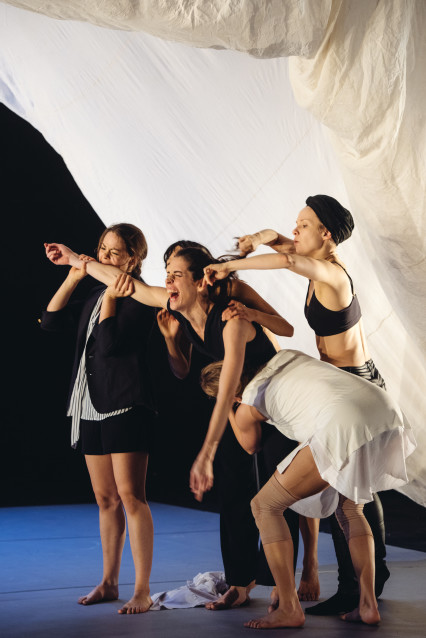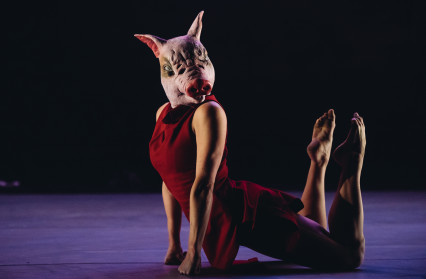Jane Oriel casts a critical eye over Shadow of a Quiet Society by Gwyn Emberton Dance at The Riverfront Theatre & Arts Centre, Newport.
All manner of young artists have escaped the stultifying confines of their hometowns, only to find an appreciation and sweet nostalgia blossoming once they return from having made their way in the world. Plays, watercolours or novels are the usual outlets but history expressed through dance is a far rarer beast.
Shadow Of A Quiet Society is choreographer and dancer Gwyn Emberton quirky love letter to the Welsh town of his birth that the press release suggests is Montgomery, Powys. Choosing to cast six female dancers, each from a different nation, gave Emberton a rich palette of skills, physiques and experiences to draw on.
 In black leather trousers and a grey fur jacket, our first character encounter is with the mincing, limping, slightly sinister-looking Master of Revels (what a great title) who, as Eddie Ladd’s recorded voice tells us with a dripping condescension, has been appointed to licence or censor all drama on behalf of the Kings Charles, I and II. It brings a smile to hear that the local man behind the office, Henry Herbert, tonight grants permission to Gwyn Emberton’s troupe for the entertainments to proceed.
In black leather trousers and a grey fur jacket, our first character encounter is with the mincing, limping, slightly sinister-looking Master of Revels (what a great title) who, as Eddie Ladd’s recorded voice tells us with a dripping condescension, has been appointed to licence or censor all drama on behalf of the Kings Charles, I and II. It brings a smile to hear that the local man behind the office, Henry Herbert, tonight grants permission to Gwyn Emberton’s troupe for the entertainments to proceed.
Several set-pieces. be they solo, duet or ensemble, are fast-paced and completely engaging, several drawing feelings of wonderment and awe. The bizarre fluidity of the Badger Dance (as helpfully identified by Eddie Ladd) is mind boggling for its six dancers as one creature. It is mesmerising to watch the many-armed thing seemingly dissolve arm bones. The composer and pig mask duet (Sophia Preidel, Eleesha Drennan) is a lustful, obsessive courtship that alludes to one time town resident Peter Warlock, best known for his haunting W.B. Yeats song cycle written in Wales, ‘The Curlew’. Almost as famous for his debauched lifestyle, I’m wondering if Emberton at some point came across a song called ‘Pigessnie’, presumed to be written by Warlock? Of the specially commissioned music supporting Shadow…, Benjamin Talbott has created an edgy presence that permeates the show, supportive of mood and attitude throughout.
The hour-long piece uses a massive array of starkly, varied dance sections, reminding us that Contemporary dance is capable of almost unlimited expression when explored by experts. The whole work has no low point where one’s imagination might wander but is fascinating to behold throughout, with or without prior plot knowledge. One section features an highly excitable woman struggling to hold the reins of dancers as (presumably) horses. She is later revealed as a famous model and socialite who arrived in a horse drawn carriage, bringing her swinging ‘60s friends and excesses with her.
 Designer Angharad Matthews has a huge, ballooning piece of white fabric as the only scenery. It hangs from a batten near the top of the proscenium and is tucked up on one side to form a diagonal presence that holds the stage rear and right side of the apron in gloom. I later learn that this represents the shadow cast over the more well-to-do parts of the town by Montgomery Castle, the Herbert family seat, and is also suggestive of the light and dark contrasts and conflicts within every living soul as expounded by 19th Century Jungian theory. This presupposition seems to be quite an add on for a dance standing capably on its own feet, so to speak, but after a climax of raging revelry (having been given the nod of approval by the ever present Master of funs), the volatile dancers pursue each other around the stage, giggling and stripping each other down to shorts and bandeaus, and the societal dark and light elements have reached breaking point, causing the aloft fabric to cascade to the ground, bringing with it a shower of party foil strips. A dark canvas is swiftly rolled from stage front to back to cover the light and the performance nears its end.
Designer Angharad Matthews has a huge, ballooning piece of white fabric as the only scenery. It hangs from a batten near the top of the proscenium and is tucked up on one side to form a diagonal presence that holds the stage rear and right side of the apron in gloom. I later learn that this represents the shadow cast over the more well-to-do parts of the town by Montgomery Castle, the Herbert family seat, and is also suggestive of the light and dark contrasts and conflicts within every living soul as expounded by 19th Century Jungian theory. This presupposition seems to be quite an add on for a dance standing capably on its own feet, so to speak, but after a climax of raging revelry (having been given the nod of approval by the ever present Master of funs), the volatile dancers pursue each other around the stage, giggling and stripping each other down to shorts and bandeaus, and the societal dark and light elements have reached breaking point, causing the aloft fabric to cascade to the ground, bringing with it a shower of party foil strips. A dark canvas is swiftly rolled from stage front to back to cover the light and the performance nears its end.
Much of my understanding of tonight’s narrative comes from the programme notes that I read after the event, as well as the post-performance talk, with impression, mood and the hugely varied expressions of physical skill remaining the dancers’ domain. It could be argued that if an art work is meant to be understood along with full historical and biographical detail, then it should be expected to have all fruits accessible within the work itself. This is also true of Hamlet if you will, but what fun has been had by hordes of scholars discussing the State, state or state of Denmark over the centuries. If Emberton had chosen to instead fly minimally with just impression and a whole gamut of intangibles, Shadow… would still have been the superb and captivating piece of work that it is, flying free with the unconscious, unburdened by the onus of being semi-obliged to concentrate on the story-telling detail. Quite a standard-setter for the rest of the year in Welsh dance.
To find out more about upcoming performances and events at The Riverfront Theatre & Arts Centre visit their website.
Jane Oriel is a regular contributor to Wales Arts Review.
(Images courtesy of Gwyn Emberton Dance)












